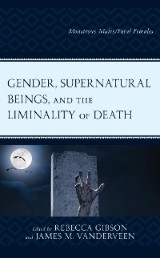Details

Gender, Supernatural Beings, and the Liminality of Death
Monstrous Males/Fatal Females|
36,99 € |
|
| Verlag: | Lexington Books |
| Format: | EPUB |
| Veröffentl.: | 02.03.2021 |
| ISBN/EAN: | 9781793641366 |
| Sprache: | englisch |
| Anzahl Seiten: | 236 |
DRM-geschütztes eBook, Sie benötigen z.B. Adobe Digital Editions und eine Adobe ID zum Lesen.
Beschreibungen
<p><a></a><span>Gender, Supernatural Beings, and the Liminality of Death: Monstrous Males/Fatal Females</span><span> examines representations of the supernatural dead to demonstrate shifts in the manifestation of gender. Including readings of East Asian detectives/cyborgs, Iranian vampires, and African zombies, among others, This collection offers a multi-faceted look at myth, legend, and popular culture representations of the gendered supernatural from a broad range of international contexts. The contributors show that, as creatures pass through the liminal space of death, their new supernatural forms challenge cultural conceptions of gender, masculinity, and femininity.</span><a></a></p>
<p><span>Gender, Supernatural Beings, and the Liminality of Death: Monstrous Males/Fatal Females</span><span> examines how gender changes and manifests in stories and film through several different types of beings. With sections on social death, the walking dead, and the undead, this is a multi-faceted look at myth, legend, and popular culture creatures.</span></p>
<p><span>Table of Contents</span></p>
<p></p>
<p><span>Preface</span></p>
<p><span>Rebecca Gibson</span></p>
<p><span>Section One: Introduction</span></p>
<p><span>Chapter 1: Transformation and Liminal Space within Fiction and Folklore</span></p>
<p><span>Freya Fenton</span></p>
<p><span>Section Two: Social Death/Cyborg Transformation</span></p>
<p><span>Chapter 2: Vengeful Monsters, Shapeshifting Cyborgs, and Alien Spider Queens: The Monstrous-Feminine in Netflix’s </span><span>Love, Death & Robots</span></p>
<p><span>Sarah Stang</span></p>
<p><span>Chapter 3: “We’re All, In the End, Part of the Same Great Thing”: Gender, Death, and Memory in Aliette de Bodard’s </span><span>The Tea Master and the Detective</span></p>
<p><span></span><span>Alex Claman</span></p>
<p><span>Chapter 4: “The House Wants Me to Stay”: Mothers, Wives and Sex Objects in the Haunted House Subgenre</span></p>
<p><span>Victor Hernández-Santaolalla</span></p>
<p><span>Section Three: Between Life and Death</span></p>
<p><span>Chapter 5: To Slay or Not to Slay: Gender, Liminality, and Choice in </span><span>Buffy the Vampire Slayer</span></p>
<p><span>Chelsi Slotten</span></p>
<p><span>Chapter 6: Fear Itself: The Vampire as Moral Panic</span></p>
<p><span>Holly Walters</span></p>
<p><span>Chapter 7: Gay Bloodsucker or Post-Soviet Buzzkill? Vampiric Possibilities in Sektor Gaza</span></p>
<p><span>Lev Nikulin</span></p>
<p><span>Chapter 8: From Femme Fatale to Fatal Female: Vampiric Power as Coded Female in </span><span>A Girl Walks Home Alone at Night</span><span> and </span><span>Only Lovers Left Alive</span></p>
<p><span>Rebecca Gibson</span></p>
<p><span>Section Four: Reanimation with Sentience</span></p>
<p><span>Chapter 9: Masculinity, and Not Femininity, As Gendered “Nature” in Cinematic Adaptations of Mary Shelley’s </span><span>Frankenstein</span></p>
<p><span>Devi Snively and Agustín Fuentes</span></p>
<p><span>Chapter 10: The Animated Dead: Reimagining the Beautiful Corpse in Tim Burton’s </span><span>Corpse Bride</span></p>
<p><span>Gillian Wittstock</span></p>
<p><span>Chapter 11: Sexual Encounters Between the Living and the (Un)dead in Popular Culture</span></p>
<p><span>Matt Coward-Gibbs and Bethan Michael-Fox</span></p>
<p><span>Section Five: Reanimation without Sentience</span></p>
<p><span>Chapter 12: Behind the Door: Sukuma </span><span>Mitunga</span><span> (Zombie) Narratives as Social Critique in Northwestern Tanzania</span></p>
<p><span>Amy Nichols-Belo</span></p>
<p><span>Chapter 13: Does Death Destroy the Binary? A Look at Gender Roles During Human/Zombie Interaction in the </span><span>World War Z</span><span> Universe</span></p>
<p><span>Rebecca Gibson and James M. VanderVeen</span></p>
<p><span>Afterlife and Afterword</span></p>
<p><span>James M. VanderVeen</span></p>
<p></p>
<p></p>
<p><span>Preface</span></p>
<p><span>Rebecca Gibson</span></p>
<p><span>Section One: Introduction</span></p>
<p><span>Chapter 1: Transformation and Liminal Space within Fiction and Folklore</span></p>
<p><span>Freya Fenton</span></p>
<p><span>Section Two: Social Death/Cyborg Transformation</span></p>
<p><span>Chapter 2: Vengeful Monsters, Shapeshifting Cyborgs, and Alien Spider Queens: The Monstrous-Feminine in Netflix’s </span><span>Love, Death & Robots</span></p>
<p><span>Sarah Stang</span></p>
<p><span>Chapter 3: “We’re All, In the End, Part of the Same Great Thing”: Gender, Death, and Memory in Aliette de Bodard’s </span><span>The Tea Master and the Detective</span></p>
<p><span></span><span>Alex Claman</span></p>
<p><span>Chapter 4: “The House Wants Me to Stay”: Mothers, Wives and Sex Objects in the Haunted House Subgenre</span></p>
<p><span>Victor Hernández-Santaolalla</span></p>
<p><span>Section Three: Between Life and Death</span></p>
<p><span>Chapter 5: To Slay or Not to Slay: Gender, Liminality, and Choice in </span><span>Buffy the Vampire Slayer</span></p>
<p><span>Chelsi Slotten</span></p>
<p><span>Chapter 6: Fear Itself: The Vampire as Moral Panic</span></p>
<p><span>Holly Walters</span></p>
<p><span>Chapter 7: Gay Bloodsucker or Post-Soviet Buzzkill? Vampiric Possibilities in Sektor Gaza</span></p>
<p><span>Lev Nikulin</span></p>
<p><span>Chapter 8: From Femme Fatale to Fatal Female: Vampiric Power as Coded Female in </span><span>A Girl Walks Home Alone at Night</span><span> and </span><span>Only Lovers Left Alive</span></p>
<p><span>Rebecca Gibson</span></p>
<p><span>Section Four: Reanimation with Sentience</span></p>
<p><span>Chapter 9: Masculinity, and Not Femininity, As Gendered “Nature” in Cinematic Adaptations of Mary Shelley’s </span><span>Frankenstein</span></p>
<p><span>Devi Snively and Agustín Fuentes</span></p>
<p><span>Chapter 10: The Animated Dead: Reimagining the Beautiful Corpse in Tim Burton’s </span><span>Corpse Bride</span></p>
<p><span>Gillian Wittstock</span></p>
<p><span>Chapter 11: Sexual Encounters Between the Living and the (Un)dead in Popular Culture</span></p>
<p><span>Matt Coward-Gibbs and Bethan Michael-Fox</span></p>
<p><span>Section Five: Reanimation without Sentience</span></p>
<p><span>Chapter 12: Behind the Door: Sukuma </span><span>Mitunga</span><span> (Zombie) Narratives as Social Critique in Northwestern Tanzania</span></p>
<p><span>Amy Nichols-Belo</span></p>
<p><span>Chapter 13: Does Death Destroy the Binary? A Look at Gender Roles During Human/Zombie Interaction in the </span><span>World War Z</span><span> Universe</span></p>
<p><span>Rebecca Gibson and James M. VanderVeen</span></p>
<p><span>Afterlife and Afterword</span></p>
<p><span>James M. VanderVeen</span></p>
<p></p>
<p><span>Rebecca Gibson</span><span> is adjunct professor in the department of sociology and anthropology at Indiana University South Bend and the department of anthropology at American University. </span></p>
<p></p>
<p><span>James M. VanderVeen</span><span> is an archaeologist and professor of anthropology at Indiana University South Bend.</span></p>
<p></p>
<p><span>James M. VanderVeen</span><span> is an archaeologist and professor of anthropology at Indiana University South Bend.</span></p>
Diese Produkte könnten Sie auch interessieren:

Pädagogik als Sorge?

von: Anna Hartmann, Jeannette Windheuser, Daniela Reimer, Sabine Andresen, Barbara Friebertshäuser, Mai-Anh Boger, Vivian Buchholz, Sina Kleinitzke, Sabine Hattinger-Allende, Barbara Rendtorff, Cornelie Dietrich, Barbara Thiessen, Denise Bergold-Caldwell, Karen Geipel, Johanna Pangritz

35,99 €
















